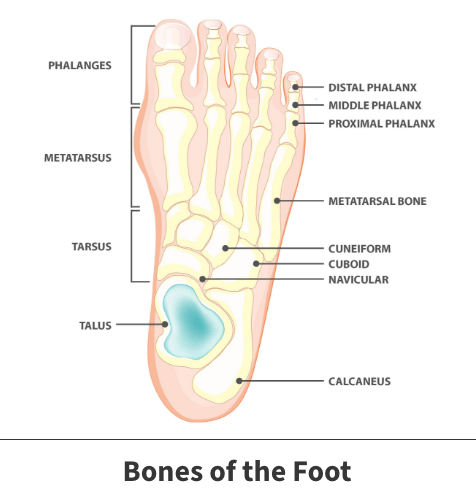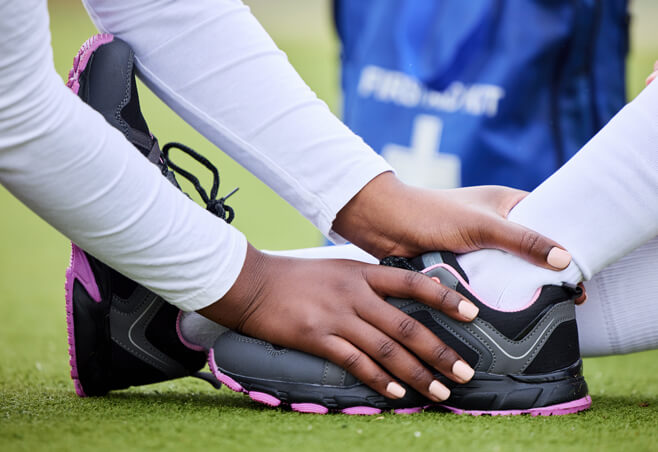Sports injuries
Common foot fractures from running & sports
One might argue that athletes’ feet are their most utilized, important, but overlooked physical features. The simple fact is that athletes cannot stand, walk, run, or jump without well-functioning and healthy feet.
The workload that athletes’ feet are exposed to increases their risk for injury. Some of the most common sports injuries such individuals face include fractures of the feet.
Anatomy

Each foot contains 26 bones. These bones come in various shapes and sizes. The main areas in the feet that are most common for foot fractures are:
- Metatarsal – These long bones are located mid-foot, extending towards the toe bones.
- Calcaneus – The calcaneus (heel bone) is the largest of the tarsal bones in the foot. It lies at the back of the foot (hindfoot) below the three bones that make up the ankle joint.
- Phalanges – The phalanges consist of the 14 bones that make up the toes.
About
Overuse or sudden injury to the foot bones can result in cracks, medically known as fractures. While there are more common areas of the foot for fractures, these events can occur in any foot bone and range in severity, from simple and uncomplicated. Fractures can cause serious deformities and threaten other nearby physical features. Four of the most common foot fractures include:
- Metatarsal fractures – The fifth metatarsal, the bone leading into the small toe, is the most frequently fractured metatarsal. The second most commonly broken metatarsal is the first one, which extends to the big toe. This is usually the most serious of such injuries and requires the most aggressive treatment. Fractures to the middle three metatarsals occur less frequently and often respond favorably to home-care treatments. Jones fractures occur in the fifth metatarsal bone, which is located on the outside of the foot.
- Heel fractures – Heel fractures impact the heel bone (calcaneus). These events are usually significant and often limit one’s ability to stand or walk.
- Stress fractures – Stress fractures are small cracks developing over an extended period. Usually, these injuries occur following repetitive stress on the affected bone from continual awkward or repetitive movements performed during athletic competition or at work.
- Toe fractures – Toe fractures involve the bones directly inside each toe (phalanges). Many injuries occur when the toe is abnormally bent, twisted, or jammed into a hard or large object.
Causes
Foot fractures usually result from strange, forceful, or sudden motion impacting the foot. In other cases, overuse weakens bones, leaving them more likely to experience breaks.
Risk factors
Athletes have a greater chance of sustaining foot fractures because they continually place excessive pressure on their feet and twist or bend them in unusual directions. Athletes at high risk are runners, tennis players, and those playing team sports such as basketball, cheerleading, gymnastics, volleyball, football, and soccer.
Symptoms
The symptoms depend on the specific bone involved, the location within the foot, and the severity of the initial impact. All foot fractures can produce common symptoms such as:
- Pain
- Discomfort that worsens when the injured foot is moved
- Noticeable swelling
- Redness
- Tenderness to the touch
- Difficulties standing or walking
In more serious instances, the affected foot might have clear deformities.
Complications
If foot fractures are not immediately addressed, you can risk developing serious, debilitating, and potentially life-threatening issues such as:
- Bone infections
- Damage to blood vessels and nerves
- Arthritis
- Tendinitis
- Chronic pain
- Permanent disability

Diagnosis
Doctors who suspect you may have some type of foot fracture often begin the diagnostic process by asking questions such as when the pain started, what kind of sports or leisure activities you take part in, and if any movements or actions worsen the discomfort.
Then they will likely do a complete visual examination to find any noticeable irregularities. Misshaped bones or other abnormalities can sometimes make diagnosis easier.
Often, foot fractures are officially confirmed using imaging devices like X-rays, MRI, or CT scans, which allow physicians to view a foot’s inner workings and easily identify fractures.
Treatment
Mild to moderate fractures often heal with time and the use of non-invasive treatment methods.
Less severe breaks like stress fractures can improve with non-surgical options over a relatively short time, provided the injured athlete limits the pressure placed upon their foot and performs home-care methods such as putting ice on the foot, restricting its movement using compressing devices like casts or ankle braces, and elevating it above their heart to reduce swelling.
Major fractures often need surgery. Common types of operations performed to correct foot fractures include:
- Reduction – During this process, surgeons place the two pieces of separated bone back together.
- Open surgery – The most serious fractures usually need open surgery. This is a more complex process that involves the insertion of metal plates and screws into the damaged bone to keep it together long enough for the bone to heal fully and properly.
Recovery
Recovery depends on many factors. The most significant issues are the fracture’s severity and the treatment used to fix it. A less severe or clean break might heal faster than a bone broken in more than one place. An athlete’s biological and physical well-being and age also play into healing time frames.
Prevention
Fractures caused by sudden occurrences like car accidents and falls are difficult to prevent. Athletes can lessen their risk of foot fractures by engaging in preventative measures such as:
- Gradually increase the intensity of any exercise program to progressively strengthen physical fitness
- Caution when exercising on different or uneven surfaces
- Use the most appropriate techniques specific to the athlete and sport
- Dynamic stretching before engaging in physical activity or competition
- Wear appropriate footwear
Athletes are urged to consume a healthy diet containing bone-strengthening nutrients like calcium and Vitamin D. Additionally, they should immediately stop any activity and seek medical care if they experience pain or other fracture-related symptoms.
Videos
Related specialties
- Achilles Calcific Tendinitis
- Achilles Tendon Rupture
- Achilles Tendonitis
- Ankle Fracture Surgery
- Ankle Fractures (Broken Ankle)
- Ankle Fusion Surgery
- Arthroscopic Articular Cartilage Repair
- Arthroscopy of the Ankle
- Bunions
- Charcot Joint
- Foot Stress Fractures
- Hallux Rigidus Surgery - Cheilectomy
- Hammer Toe
- High Ankle Sprain (Syndesmosis Ligament Injury)
- Intraarticular Calcaneal Fracture
- Lisfranc Injuries
- Mallet, Hammer & Claw Toes
- Metatarsalgia
- Neuromas (Foot)
- Plantar Fasciitis
- Sprained Ankle
- Total Ankle Replacement
- Turf Toe
